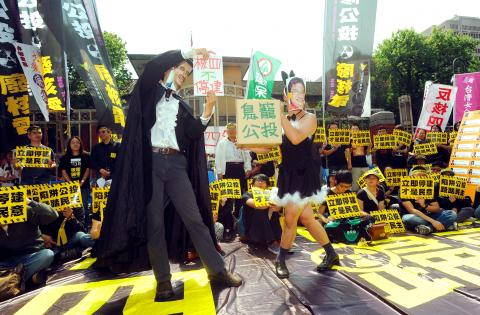The Executive Yuan yesterday said Taiwan will face electricity shortages, higher electricity rates and could invite international trade sanctions due to elevated carbon dioxide emissions if the incomplete Fourth Nuclear Power Plant in New Taipei City’s (新北市) Gongliao District (貢寮) is scrapped.
Halting construction of the controversial plant could also lead to a slump in the stock market and political and economic instability, the Executive Yuan said in a brochure compiled by the Ministry of Economic Affairs yesterday.
Written in a question-and-answer format, the brochure lists 25 arguments often raised by anti-nuclear activists to demand an immediate halt to the plant, followed by counterarguments.

Photo: Wang Yi-sung, Taipei Times
The pamphlet aims to convince the public that Taiwan needs to finish building the plant if it is to embark on a path to a low-carbon environment and a nuclear-free homeland.
According to the brochure, halting the project would put the nation at risk of having to ration electricity from 2015, when the unused capacity is estimated to be between 5 percent and 10 percent, with the risk intensifying to a real threat in 2018.
If the power plant does not become operational next year as scheduled, electricity prices will increase by 35 to 42 percent in 2016 and by 13 to 15 percent in 2018 compared with the rates recorded in October this year, the brochure says.
The Executive Yuan insisted that the plant is capable of producing the cheapest energy in Taiwan, at a price of less than NT$2 per kilowatt-hour, adding the costs of nuclear waste disposal and the decommissioning of the plant is included in the electricity price.
If the plant is abandoned, the nation would have to increase its reliance on fossil fuels — likely coal and gas — to meet electricity demand, the brochure says.
The problem of meeting the growing demand for energy cannot be immediately solved with alternative energy sources due to the various obstacles and difficulty of developing solar, wind or geothermal energy, the brochure says.
In that case, Taiwan wouid emit an additional of 7.51 million to 16.19 million tonnes of carbon dioxide per year, rendering it impossible for the country to reach its target of reducing emissions, the Executive Yuan said.
The brochure includes a section that seeks to address safety issues in which it rebutts an article published by Nature magazine in April 2011 that ranked two of Taiwan’s plants in a list of the world’s three most dangerous nuclear power plants.
The operational performance of Taiwan’s nuclear reactors have been rated above world standards by the International Atomic Energy Agency, it said.

Three Taiwanese airlines have prohibited passengers from packing Bluetooth earbuds and their charger cases in checked luggage. EVA Air and Uni Air said that Bluetooth earbuds and charger cases are categorized as portable electronic devices, which should be switched off if they are placed in checked luggage based on international aviation safety regulations. They must not be in standby or sleep mode. However, as charging would continue when earbuds are placed in the charger cases, which would contravene international aviation regulations, their cases must be carried as hand luggage, they said. Tigerair Taiwan said that earbud charger cases are equipped

UNILATERAL MOVES: Officials have raised concerns that Beijing could try to exert economic control over Kinmen in a key development plan next year The Civil Aviation Administration (CAA) yesterday said that China has so far failed to provide any information about a new airport expected to open next year that is less than 10km from a Taiwanese airport, raising flight safety concerns. Xiamen Xiangan International Airport is only about 3km at its closest point from the islands in Kinmen County — the scene of on-off fighting during the Cold War — and construction work can be seen and heard clearly from the Taiwan side. In a written statement sent to Reuters, the CAA said that airports close to each other need detailed advanced

Tropical Storm Fung-Wong would likely strengthen into a typhoon later today as it continues moving westward across the Pacific before heading in Taiwan’s direction next week, the Central Weather Administration (CWA) said. As of 8am, Fung-Wong was about 2,190km east-southeast of Cape Oluanpi (鵝鑾鼻), Taiwan’s southernmost point, moving westward at 25kph and possibly accelerating to 31kph, CWA data showed. The tropical storm is currently over waters east of the Philippines and still far from Taiwan, CWA forecaster Tseng Chao-cheng (曾昭誠) said, adding that it could likely strengthen into a typhoon later in the day. It is forecast to reach the South China Sea

WEATHER Typhoon forming: CWA A tropical depression is expected to form into a typhoon as early as today, the Central Weather Administration (CWA) said yesterday, adding that the storm’s path remains uncertain. Before the weekend, it would move toward the Philippines, the agency said. Some time around Monday next week, it might reach a turning point, either veering north toward waters east of Taiwan or continuing westward across the Philippines, the CWA said. Meanwhile, the eye of Typhoon Kalmaegi was 1,310km south-southeast of Oluanpi (鵝鑾鼻), Taiwan’s southernmost point, as of 2am yesterday, it said. The storm is forecast to move through central